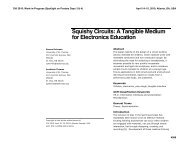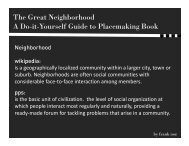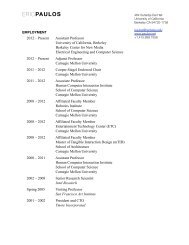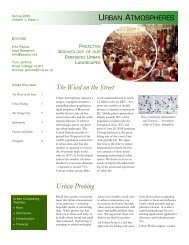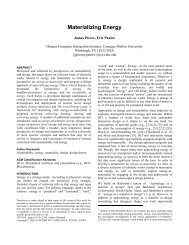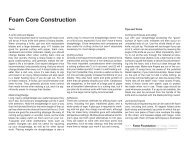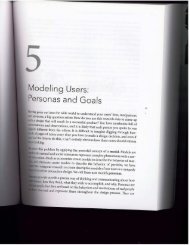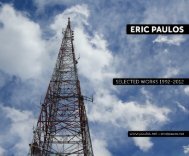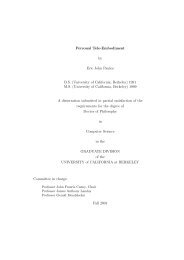The Foundations of Design: Scenarios and Requirements
The Foundations of Design: Scenarios and Requirements
The Foundations of Design: Scenarios and Requirements
- No tags were found...
You also want an ePaper? Increase the reach of your titles
YUMPU automatically turns print PDFs into web optimized ePapers that Google loves.
<strong>The</strong> <strong>Foundations</strong> <strong>of</strong> <strong>Design</strong>:<strong>Scenarios</strong> <strong>and</strong> <strong>Requirements</strong>In the two previous chapters, we talked about how to gather qualitative informationabout users <strong>and</strong> create models using that information. Through careful analy_<strong>of</strong> user research <strong>and</strong> synthesis <strong>of</strong> personas <strong>and</strong> other user models, we create ar picture <strong>of</strong>OUf users <strong>and</strong> their respective goals. This brings us, then, to the cruxthe whole method: how we use this underst<strong>and</strong>ing <strong>of</strong> people to create designlions that satisfy <strong>and</strong> inspire users, while simultaneously addressing business<strong>and</strong> technical constraints.chapter describes the first part <strong>of</strong> a process for bridging the research-designIt employs personas as the main characters in a set <strong>of</strong> techniques that rapidlyat design solutions in an iterative, repeatable, <strong>and</strong> testable fashion. Thishas four major activities: developing stories or scenarios as a means <strong>of</strong>ing ideal user interactions, using those scenarios to define requirements,the~ requirements in turn to define the fundamentaJ interaction frameworkproduct, <strong>and</strong> filling in the framework with ever-increasing amounts <strong>of</strong>dttail. <strong>The</strong> glue that holds the processes together is narrative: using personas510ries that point to design.
'10 Part I: Underst<strong>and</strong>ing Goal-Directed <strong>Design</strong><strong>Scenarios</strong>: Narrative as a <strong>Design</strong> ToolNarrative, or storytelling, is one <strong>of</strong>the oldest human activities. Much has been writtenabout the power <strong>of</strong> narrative to communicate ideas. However, narrative is alsoone <strong>of</strong> our most powerful creative methods. From a very young age, we are accustomedto using stories to think about possibilities, <strong>and</strong> this is an incredibly effectiveway to imagine a new <strong>and</strong> better future for our users. Imagining a storyabout a per·son using our product leverages aUf creativity to a greater power than when we justimagine a better form factor or configuration <strong>of</strong>screen elements. Further, because<strong>of</strong> the intrinsically social aspect <strong>of</strong> narrative, it is a very effective <strong>and</strong> compellingway to share good ideas among team members <strong>and</strong> stakeholders. Ultimately, experiencesdesigned around narrative tend to be more comprehensible <strong>and</strong> engagingfor users because they are structured around a story.Evidence <strong>of</strong> the effectiveness <strong>of</strong> narrative as a design tool is all around us. <strong>The</strong>famous Disney Imagineers would be lost without the modem-day myths they useas the foundation for the experiences they build. Much has been written about thisidea: Brenda Laurel explored the concept <strong>of</strong> structuring interaction arounddramatic principles in her 1991 hook Computers as <strong>The</strong>ater, where she urges us 10"... focus on designing the action. <strong>The</strong> design <strong>of</strong> objects, environments, <strong>and</strong> char·acters is all subsidiary to this central goal."l John Rheinfrank <strong>and</strong> Shelley Evensonalso talk about the power <strong>of</strong> "stories <strong>of</strong> the future" for developing conceptuallycomplex interactive systems, 2 <strong>and</strong> John Carroll has created a substantial body <strong>of</strong>work about scenario-based design, which we discuss later in this chapter.Narrative also lends itself to effective visual depictions <strong>of</strong> interactive products.Because interaction design is first <strong>and</strong> foremost the design <strong>of</strong>behavior that occursover time, a narrative structure, combined with the support <strong>of</strong> fast <strong>and</strong> flexiblevisualization tools (such as the humble wruteboard), is perfectly suited for motivating,envisioning, representing, <strong>and</strong> validating interaction concepts.Interaction design narratives are quite similar to the comic-hook-like sequenctscalled storyboards that are used in the motion picture industry. <strong>The</strong>y share two sig·nificant characteristics: plot <strong>and</strong> brevity. Just as storyboards breathe life into amovie script, design solutions should be created <strong>and</strong> rendered to follow a plot - Jstory. Putting too much detail into the storyboards simply wastes time <strong>and</strong> mon<strong>and</strong> has a tendency to tie us to suboptimal ideas simply because drawing themsumes significant resources.In the initial requirements definition phase we are free to focus only on the ..points," allowing US to be fluid as we explore design concepts. Because they areto convey the action <strong>and</strong> the potential experience, many millions <strong>of</strong>Hollywoodhavebeelon the nsolution'Producti
Chapter 6: <strong>The</strong> <strong>Foundations</strong> <strong>of</strong> <strong>Design</strong>: <strong>Scenarios</strong> <strong>and</strong> <strong>Requirements</strong> 111have been invested on the basis <strong>of</strong>simple pencil sketches or line drawings. By focusingon the narrative, we are able to quickly <strong>and</strong> flexibly arrive at a high-level designsolution without getting bogged-down by the inertia <strong>and</strong> expense inherent to highproduction-valuerenderings (though such renderings are certainly appropriate oncea working design framework is in place).<strong>Scenarios</strong> in designIn the 1990s, substantial work was done by the HCI (Human-Computer Interaction)community around the idea <strong>of</strong> use-oriented s<strong>of</strong>tware design. From this workcame the concept <strong>of</strong> the scenario, commonly used to describe a method <strong>of</strong> designproblem solving by concretization: making use <strong>of</strong> a specific story to both construct<strong>and</strong> illustrate design solutions. <strong>The</strong>se concepts are discussed by John Carroll, in hisbook, Making Use:<strong>Scenarios</strong> are paradoxically concrete but rough, tangible but flexible . . , theyimplicitly encourage "what-if?" thinking among all parties. <strong>The</strong>y permit thearticulation <strong>of</strong>design possibilities without undermining innovation, , . <strong>Scenarios</strong>compel attention to the use that will be made <strong>of</strong>the design product. <strong>The</strong>y c<strong>and</strong>escribe situations at many levels <strong>of</strong>detail, for many different purposes, helpingto coordinate various aspects <strong>of</strong>the design project. 3Carroll's use <strong>of</strong>scenario-based design focuses on describing how users accomplishlasks. It consists <strong>of</strong> an environmental setting <strong>and</strong> includes agents or actors thatare abstracted st<strong>and</strong>-ins for users, with role-based names such as Accountant orProgrammer.Although Carroll certainly underst<strong>and</strong>s the pOwer <strong>and</strong> importance <strong>of</strong> scenarios indesign process, we've found two shortcomings with scenarios as Carrollroaches them:~ Carroll's concept <strong>of</strong> the actor as an abstracted, role-oriented model is not sufficientlyconcrete to prOVide underst<strong>and</strong>ing <strong>of</strong> or empathy with users. It is impossibleto design appropriate behaviors for a system without underst<strong>and</strong>ing theusers <strong>of</strong> the system in specific detail.Carroll's scenarios jump too quickly to the elaboration <strong>of</strong> tasks without consideringthe user's goals <strong>and</strong> motivations that drive <strong>and</strong> filter these tasks. AlthoughCarroll does briefly discuss goals, he refers only to goals <strong>of</strong> the scenario. <strong>The</strong>segoals are circularly defined as the completion <strong>of</strong> specific tasks. In our experience,U5er goals must be considered before user tasks can be identified <strong>and</strong> prioritized.Without addressing the motivation <strong>of</strong> human behavior, high-level productdefinition can be difficult <strong>and</strong> misguided.
112 Part I: Underst<strong>and</strong>ing Goal-Directed <strong>Design</strong>-<strong>The</strong> missing ingredient in Carroll's scenario-based design methods is the use <strong>of</strong>personas. A persona provides a tangible representation <strong>of</strong>the user to act as a believ.able agent in the setting <strong>of</strong> a scenario. In addition to reflecting current behaviorpatterns <strong>and</strong> motivations, personas enable the exploration <strong>of</strong>how user motivationsshould inflect <strong>and</strong> prioritize tasks in the future. Because personas model goals <strong>and</strong>not simply tasks, the scope <strong>of</strong> the problems addressed by scenarios can be broadenedto include those related to product definition. <strong>The</strong>y help answer the questions,"What should this product do?" <strong>and</strong> "How should this product look <strong>and</strong> behavd"Using personas in scenariosPersona-basedscenarios are concise narrative descriptions<strong>of</strong>oneor more personasusing a product to achieve specific goals. <strong>The</strong>y allow us to start our designs from astory describing an ideal experience from the persona's perspective, focusing onpeople, <strong>and</strong> how they think <strong>and</strong> behave, rather than on technology or business goals.<strong>Scenarios</strong> can capture the nonverbal dialogue 4 between the user <strong>and</strong> a product, environment,or system over time, as well as the structure <strong>and</strong> behavior <strong>of</strong> interactivefunctions. Goals serve as a filter for tasks <strong>and</strong> as guides for structuring the display <strong>of</strong>information <strong>and</strong> controls during the iterative process <strong>of</strong>constructing the scenarios.Scenario content <strong>and</strong> context are derived from infonnation gathered during theResearch phase <strong>and</strong> analyzed during the Modeling phase. <strong>Design</strong>ers role-play personasas the characters in these scenarios,S similar to actors performing improvisation.This process leads to real·time synthesis <strong>of</strong> structure <strong>and</strong> behaviortypically,at a whiteboard - <strong>and</strong> later informs the detailed look-<strong>and</strong>·feel. Finall)",personas <strong>and</strong> scenarios are used to test the validity <strong>of</strong>design ideas <strong>and</strong> assumptionsthroughout the process.Different types <strong>of</strong> scenarios<strong>The</strong> Goal-Directed <strong>Design</strong> method employs three types <strong>of</strong>persona-based scenamat different points in the process, each with a successively more interface-specificfocus. <strong>The</strong> first - the context scenario - is used to explore, at a high level, how meproduct can best serve the needs <strong>of</strong>the personas. (We used to call these "day-inlifescenarios," but found that term excessively broad.) <strong>The</strong> context scenarios artated before any design is performed <strong>and</strong> are written from the perspective <strong>of</strong>persona, focused on human activities, perceptions, <strong>and</strong> desires. It is in the de'\ment <strong>of</strong>this kind <strong>of</strong>scenario that the designer has the most leverage to imagineideal Us.fOund 1
Chapter 6: <strong>The</strong> <strong>Foundations</strong> <strong>of</strong> <strong>Design</strong>: <strong>Scenarios</strong> <strong>and</strong> <strong>Requirements</strong> 113ideal user experience. More detail about the creation <strong>of</strong>this type <strong>of</strong>scenario can befound later in this chapter, under Step 4 in the <strong>Requirements</strong> Definition process.Once the design team has defined the product's functional <strong>and</strong> data elements, <strong>and</strong>developed a <strong>Design</strong> Framework (as described in Chapter 7), a context scenario isrevised to become a keypath scenario by more specifically describing user interactionswith the product <strong>and</strong> by introducing the vocabulary <strong>of</strong>the design. <strong>The</strong>se scenariosfocus on the most significant user interactions, always maintaining attentionon how a persona uses the product to achieve their goals. Key path scenarios areiteratively refined along with the design as more <strong>and</strong> more detail is developed.Throughout this process, the design team uses validation scenarios to test thedesign solution in a variety <strong>of</strong> situations. <strong>The</strong>se scenarios tend to be less detailed<strong>and</strong> typically take the form <strong>of</strong> a number <strong>of</strong> "what if..." questions about the proposedsolutions. More detail about development <strong>and</strong> use <strong>of</strong>key path <strong>and</strong> validationscenarios can be found in Chapter 7.Persona-based scenarios versus use cases<strong>Scenarios</strong> <strong>and</strong> use cases are both methods <strong>of</strong>describing a user's interaction with asystem. However, they serve very different functions. Goal-Directed scenarios arean iterative means <strong>of</strong>defining the behavior <strong>of</strong>a product from the st<strong>and</strong>point <strong>of</strong>specificusers (personas). This includes not only the functionality <strong>of</strong> the system, butthe priority <strong>of</strong>functions <strong>and</strong> the way those functions are expressed in terms <strong>of</strong>whatthe user sees <strong>and</strong> how she interacts with the system.Ust cases, on the other h<strong>and</strong>, are a technique based on exhaustive descriptions <strong>of</strong>functional requirements <strong>of</strong>the system, <strong>of</strong>ten <strong>of</strong>a transactional nature, focusing onlow-level user action <strong>and</strong> accompanying system response. 6 <strong>The</strong> precise behavior <strong>of</strong>system - precisely how the system responds _ is not typically part <strong>of</strong>a contionalor concrete use case; many assumptions about the form <strong>and</strong> behavior <strong>of</strong>system to be designed remain implicit.7 Use cases permit a complete catalogu_<strong>of</strong> user tasks for different classes <strong>of</strong> users but say little or nothing about howtasks are presented to the user or how they should be prioritized in the interIn our experience, the biggest shortcoming <strong>of</strong> traditional use cases as a basisinteraction design is their tendency to treat all possible user interactions asylikely <strong>and</strong> important. This is indicative <strong>of</strong>their origin in s<strong>of</strong>tware engineerlherthan interaction design. <strong>The</strong>y may be useful in identifying edge cases <strong>and</strong>ermining that a product is functionally complete, but they should beonly in the later stages <strong>of</strong>design validation.
114 Part I: Underst<strong>and</strong>ing Goal-Directed <strong>Design</strong><strong>Requirements</strong>: <strong>The</strong> "What" <strong>of</strong>Interaction <strong>Design</strong><strong>The</strong> <strong>Requirements</strong> Definition phase determines the what <strong>of</strong>the design: what information<strong>and</strong> capabilities our personas require to accomplish their goals. It isabsolutely critical to define <strong>and</strong> agree upon the what before we move on to the nextquestion: how the product looks, behaves, operates, <strong>and</strong> feels. Conflating these twoquestions can be one <strong>of</strong> the biggest pitfalls in the design <strong>of</strong> an interactive product.Many designers are tempted to jump right into active design <strong>and</strong> render possiblesolutions. Regardless <strong>of</strong> how creative <strong>and</strong> skillful you are, we urge you not to dothis. It runs the risk <strong>of</strong> turning into a never-ending circle <strong>of</strong> iteration; proposing asolution without clearly defining <strong>and</strong> agreeing upon the problem leaves you withouta dear method <strong>of</strong>evaluating the fitness <strong>of</strong>the design. In lieu <strong>of</strong> such a method,you, your stakeholders, <strong>and</strong> your clients are likely to resort to taste <strong>and</strong> gut instinct,which have a notoriously low success ratio with something as complex as an interactiveproduct.DESIGN~princiPle~Define what the product will do before you design how the productwill do it.It's important to note that our concept <strong>of</strong> a "requirement" here is much differentfrom the way the term is commonly misused in the industry. In many productdevelopmentorganizations, "requirement" has come to be synonymous with "feature"or "function." While there is clearly a relationship between requirements <strong>and</strong>functions (which we leverage as a key part <strong>of</strong> our design process, as you will see inthe next chapter), we suggest that you think <strong>of</strong> requirements as synonymous withneeds. Put another way, at this point, you want to rigorously define the human <strong>and</strong>business needs that your product must satisfy.Another critical reason not to conflate requirements with features is that in figuringout the best way to meet a particular human need, an interaction designer hasan extraordinary amount <strong>of</strong>leverage to create a powerful <strong>and</strong> compelling product.Think, for example, about designing a data analytics tool to help an executive better underst<strong>and</strong> the state <strong>of</strong> his business. If you jump right to the how withounderst<strong>and</strong>ing the what, you might assume that the output <strong>of</strong> the tool shouldreports. It would be easy to come to this conclusion; ifyou went out <strong>and</strong> perforuser research, you probably would have noticed that reports are a very widesp<strong>and</strong> aceelUsers' actway to reilems ariseisn't difficneeds. Witseveral <strong>of</strong> ttrends. Mureal-time trA final reas
Chapter 6: <strong>The</strong> <strong>Foundations</strong> <strong>of</strong> <strong>Design</strong>: <strong>Scenarios</strong> <strong>and</strong> <strong>Requirements</strong> 115<strong>and</strong> accepted solution. However, if you imagine some scenarios <strong>and</strong> analyze yourusers' actual requirements, you might realize that your executive actually needs away to recognize exceptional situations before opportunities are missed or problemsarise, as well a way to underst<strong>and</strong> emerging trends in the data. From here, itisn't difficult to see that static, flat reports are hardly the best way to meet theseneeds. With such a solution, your executive has to do the hard work <strong>of</strong>scrutinizingseveral <strong>of</strong> these reports to find the significant data underlying such exceptions <strong>and</strong>trends. Much better solutions might include data-driven exception reporting orreal-time trend monitors.A final reason to separate problem <strong>and</strong> solution is that such an approach providesthe maximum flexibility in the changing face <strong>of</strong> technological constraints <strong>and</strong>opportunities. By clearly defining the user need, designers can then work with technologiststo find the best solutions, without compromising the product's ability tohelp people achieve their goals. Working in this manner, the product definition isnot at risk when the implementation runs into problems, <strong>and</strong> it becomes possibleto plan long-term technology development so that it can provide increasinglysophisticated ways <strong>of</strong>meeting user needs.As we've mentioned briefly, these requirements come from several Sources. PerSOnas' previous experiences <strong>and</strong> mental models <strong>of</strong>ten result in some baseline expectations<strong>of</strong>the product. We derive the bulk <strong>of</strong>the user requirements from analyzingideal usage scenarios, <strong>and</strong> underst<strong>and</strong> business <strong>and</strong> technical requirements fromour stakeholder interviews. Our Goal-Directed process for defining productrequirements is described below.<strong>Requirements</strong> Definition UsingPersonas <strong>and</strong> <strong>Scenarios</strong>Asdiscussed briefly in Chapter I, the translation from robust models to design solunsreally consists <strong>of</strong> two major phases: <strong>Requirements</strong> Definition answers thedquestions about what a product is <strong>and</strong> what it should do, <strong>and</strong> Frameworknilion answers questions about how a product behaves <strong>and</strong> how it is structuredmeet user goals. In this section, we'll discuss <strong>Requirements</strong> Definition in detail,ed by a discussion <strong>of</strong> the Framework Definition in Chapter 7. <strong>The</strong> methodslbed are based upon the persona-based scenario methodology developed atr by Robert Reimann, Kim Goodwin, Dave Cronin, Wayne Greenwood, <strong>and</strong>Halley.
'16 Part I: Underst<strong>and</strong>ing Goal-Directed <strong>Design</strong><strong>The</strong> <strong>Requirements</strong> Definition process comprises the following five steps (which aredescribed in detail in the remainder <strong>of</strong> this chapter):1. Creating problem <strong>and</strong> vision statements2. Brainstorming3. Identifying persona expectations4. Constructing context scenarios5. Identifying requirementsAlthough these steps proceed in roughly chronological order. they represent aniterative process. <strong>Design</strong>ers can expect to cycle through Steps 3 through 5 severaltimes until the requirements are stable. This is a necessary part <strong>of</strong> the process <strong>and</strong>shouldn't be short-circuited. A detailed description <strong>of</strong> each <strong>of</strong> these steps follows.Step 1: Creating problem <strong>and</strong> vision statementsBefore beginning the process <strong>of</strong>ideation, it's important for designers to have a clearm<strong>and</strong>ate for moving forward. While the Goal-Directed method aims to comprehensivelydefine the product through personas, scenarios, <strong>and</strong> requirements, it is<strong>of</strong>ten useful at this point to define what direction these scenarios <strong>and</strong> requirementsshould be headed in. At this point in the process, we already have a sense <strong>of</strong> whichusers we're targeting <strong>and</strong> what their goals are, but lacking a clear product m<strong>and</strong>ate,there is still room for considerable confusion. Problem <strong>and</strong> vision statements pro~vide just such a m<strong>and</strong>ate <strong>and</strong> are extremely helpful in building consensus amongstakeholders before the design process moves forward.At a high level, the problem statement defines the purpose <strong>of</strong>the design initiative. sA design problem statement should concisely reflect a situation that needs changing,for both the personas <strong>and</strong> for the business providing the product to the personas.Often a cause-<strong>and</strong>-effect relationship exists between business concerns <strong>and</strong>persona concerns. For example:Company X's customer satisfaction ratings are low <strong>and</strong> market share has diminishedby 10% over the past year because users don't have adequate tools to per~form X, Y, <strong>and</strong> Z tasks that would help them meet their goal <strong>of</strong> G.<strong>The</strong> connection <strong>of</strong>business issues to usability issues is critical to drive stakeholders'buy-in to design efforts <strong>and</strong> to frame the design effort in terms <strong>of</strong> both user <strong>and</strong>business goals.<strong>The</strong> vhhigh-le1user's ndesign v<strong>The</strong> nto pefjprobleCampI<strong>The</strong> contIresearch
Chapter 6: <strong>The</strong> <strong>Foundations</strong> <strong>of</strong> <strong>Design</strong>: <strong>Scenarios</strong> <strong>and</strong> <strong>Requirements</strong> 117<strong>The</strong> vision statement is an inversion <strong>of</strong> the problem statement that serves as ahigh-level design objective or m<strong>and</strong>ate. In the vision statement, you lead with theuser's needs, <strong>and</strong> you transition from those to how business goals are met by thedesign vision:<strong>The</strong> new design <strong>of</strong>Product X will help users achieve G by giving them the abilityto perform X, 1'; <strong>and</strong> Z with greater [accuracy, efficiency, <strong>and</strong> so on}, <strong>and</strong> withoutproblems A, B, C that they currently experience. This will dramatically improveCompany X's customer satisfaction ratings <strong>and</strong> lead to increased market share.<strong>The</strong> content <strong>of</strong>both the problem <strong>and</strong> vision statements should come directly fromresearch <strong>and</strong> user models. User goals <strong>and</strong> needs should derive from the primary<strong>and</strong> secondary personas, <strong>and</strong> business goals should be extracted from stakeholderinterviews.Problem <strong>and</strong> vision statements are useful both when you are redesigning an existingproduct <strong>and</strong> for new technology products or products being designed for unexploredmarket niches, when formulating user goals <strong>and</strong> frustrations into problem<strong>and</strong> vision statements helps to establish team consensus <strong>and</strong> attention on the priorities<strong>of</strong>design activity to follow.Step 2: BrainstormingAt the early stage <strong>of</strong> <strong>Requirements</strong> Definition, brainstorming assumes a somewhatironic purpose. At this point in the project, we have been researching <strong>and</strong> modelingusers <strong>and</strong> the domain for days or even months, <strong>and</strong> it is almost impossible to avoidhaving developed some preconceptions about what the solution looks like. Howt'o't'r,we'd ideally like to create context scenarios without these prejudgments,<strong>and</strong> instead really focus on how our personas would likely want to engage withtile product. <strong>The</strong> reason we brainstorm at this point in the process is to get theseout <strong>of</strong>our heads so that we can record them <strong>and</strong> thereby "let them go" for theebeing.primary purpose here is to eliminate as much preconception as possible, allowdesignersto be open-minded <strong>and</strong> flexible as they use their imagination to con-t scenarios, <strong>and</strong> use their analytic minds to derive requirements from theserios. Aside benefit <strong>of</strong> brainstorming at this point in the process is to switchbrain into "solution mode." Much <strong>of</strong>the work performed in the Research <strong>and</strong>ling phases is analytical in nature, <strong>and</strong> it takes a different mindset to come upinventive designs.
118 Part I: Underst<strong>and</strong>ing Goal-Directed <strong>Design</strong>Brainstorming should be unconstrained <strong>and</strong> uncritical- put all the wacky ideasyou've been considering (plus some you haven't) out on the table <strong>and</strong> then be preparedto record them <strong>and</strong> me them away for safekeeping until much later in theprocess. It's not necessarily likely any <strong>of</strong> them will be useful in the end, but theremight be the germ <strong>of</strong> something wonderful that will fit into the design frameworkyou later create. Karen Holtzblatt <strong>and</strong> Hugh Beyer describe a facilitated method forbrainstorming that can be useful for getting a brainstorming session started, especialIyif your team includes nondesigners. 9Don't spend too much time on the brainstorming step; a few hours should be morethan sufficient for you <strong>and</strong> your teammates to get all those crazy ideas out <strong>of</strong>yoursystems. If you find your ideas getting repetitious, or the popcorn stops popping,that's a good time to stop.Step 3: Identifying persona expectationsAs we discussed in Chapter 2, a person's mental model is their own internal representation<strong>of</strong> reality - the way they think about or explain something to themselves.Mental models are deeply ingrained <strong>and</strong> are <strong>of</strong>ten the result <strong>of</strong> a lifetime <strong>of</strong>experience. People's expectations about a product <strong>and</strong> the way it works are highlyinformed by their mental model.Returning to our discussion in Chapter 2, it's absolutely critical that the representedmodel <strong>of</strong> the interface - how the design behaves <strong>and</strong> presents itselfshouldmatch the user's mental model as closely as possible, rather than reflectingthe implementation model <strong>of</strong> how the product is actually constructed internally.In order to accomplish this, we must formally record these expectations. <strong>The</strong>y willbe an important source <strong>of</strong> requirements. For each primary <strong>and</strong> secondary persona,you must identify:~ Attitudes, experiences, aspirations, <strong>and</strong> other social, cultural, environmental, <strong>and</strong>cognitive factors that inAuence the persona's expectations~ General expectations <strong>and</strong> desires the persona may have about the experience 01using the product• Behaviors the persona will expect or desire from the product• How that persona thinks about basic elements or units <strong>of</strong> data (for example, in afle-mail application, the basic elements <strong>of</strong> data might be messages <strong>and</strong> people)Your persona descriptions may contain enough information to answer thquestions directly; however, your research data will remain a rich resource. Use itanalyze ho<strong>of</strong> their wthings to 10• Wh• Wh~ Whi(HinStep 4:,While all Scelare the most:activities, as \',the broad can<strong>and</strong>organizatiAs we discusse,you should bepersonas achie'that each prim.other personas)Context scenarildescribe producfrom the user's Iwe can systemaldesign appropriaContext scenario:~ In what se~ Will it be l.. Is the pers,.. Are there n.. With what (.. What prima.. What is the,.. How much c,
Chapter 6: <strong>The</strong> <strong>Foundations</strong> <strong>of</strong> <strong>Design</strong>: <strong>Scenarios</strong> <strong>and</strong> <strong>Requirements</strong> 119analyze how interview subjects define <strong>and</strong> describe objects <strong>and</strong> actions that are part<strong>of</strong> their usage patterns, along with the language <strong>and</strong> grammar they use. Somethings to look for include:.. What do the subjects mention first?.. Which action words (verbs) do they use?.. Which intermediate steps, tasks, or objects in a process don'tthey mention?(Hint: <strong>The</strong>se might not be terribly important to the way they think about things.)Step 4: Constructing context scenariosWhile all scenarios are stories about people <strong>and</strong> their activities, context scenariosare the most storylike <strong>of</strong> the three types we employ. <strong>The</strong> focus is on the persona'sactivities, as well as her motivations <strong>and</strong> mental model. Context scenarios describethe broad context in which usage patterns are exhibited <strong>and</strong> include environmental<strong>and</strong> organizational (in the case <strong>of</strong>enterprise systems) considerations. 10AJj we discussed above, this is where design begins. As you develop context scenarios,you should be focusing on how the product you are designing can best help yourperSOnas achieve their goals. Context scenarios establish the primary touch pointsthat each primary <strong>and</strong> secondary persona has with the system (<strong>and</strong> possibly withother personas) over the course <strong>of</strong>a day or some other meaningful length <strong>of</strong>time.Context scenarios should be broad <strong>and</strong> relatively shallow in scope. <strong>The</strong>y should notdescribe product or interaction detail but rather should focus on high-level actionsfrom the user's perspective. It is important to map out the big picture first so thatWt can systematically identify user requirements. Only then will we be able todtsign appropriate interactions <strong>and</strong> interfaces.Ulntext scenarios address questions such as the following:.. In what sening(s) will the product be used?.. Will it be used for extended amounts <strong>of</strong> time?.. Is the persona frequently interrupted?.. Are there multiple users on a single workstation or device?.. With what other products will it be used?.. VoJhat primary activities does the persona need to perform to meet her goals?.. What is the expected end result <strong>of</strong> using the product?.. How much complexity is permissible, based on persona skill <strong>and</strong> frequency <strong>of</strong> use?
120 Part \: Underst<strong>and</strong>ing Goal_Directed <strong>Design</strong>Context scenarios should no' represent system hehaviors as they currently are.<strong>The</strong>se scenarios represent the brave new world <strong>of</strong> Goal-Directed products, so, especiallyin the initial phases, focus on the goals. Don't yet worry about exactly howthings will get accomplished _ you should initially treat tbe design as a bit <strong>of</strong> amagic black box.In most cases, more than one context scenario is necessary. This is true especiallywhen there are multiple prim"y personas, but sometimes even a single primarypersona may have twO or more distinct contexts <strong>of</strong> use.Context scenarios are also entirely textual. We are not yet discussing form, only thebehaviors <strong>of</strong> the user <strong>and</strong> the system. This discussion is best accomplished as atextual narrative.An example context scenario<strong>The</strong> following is an example <strong>of</strong> a first iteration <strong>of</strong> a context scenario for a primarypersona for a personal digital assistant (PDA) type phone, including both thedevice <strong>and</strong> its service. Om persona is Vivien Strong, a real-estate agent in Indianapolis,whose goals are to balance work <strong>and</strong> home life, close the deal, <strong>and</strong> makeeach client feel like he is her only client.Vivien's context scenario:1. While getting ready in the morning, Vivien uses her phone to check her e_mail. Ithas a large enough screen <strong>and</strong> quick connection time so that it's more convenientthan booting up a computer as she rushes to make her daughter, Alice, as<strong>and</strong>wich for school.2, Vivien sees an e-mail hom her newest client. Frank, who wants to see a housethis afternoon. <strong>The</strong> device has his contact info, so noW she can call him with asimple action right from the e-mail.3. While on the phone with Frank, Vivien switches to speakerphone so she can lookat the screen while talking. She looks at her appointments to see when she's freeWhen she creates a new appointment, the phone automatically makes it anappointment with Frank, because it knowS with whom she is talking. She quicklyenters the address <strong>of</strong> the property into the appointment as she finishes herconversation.4. After sending Alice <strong>of</strong>f to school. Vivien heads into the real-estate <strong>of</strong>fice togathe, some papers foe anothe, appointment Her phone has already "pdatedher Outlook appointments, so the rest <strong>of</strong> the <strong>of</strong>fice knows where she'll be in theafternoon.5. <strong>The</strong> day goes by quickly, <strong>and</strong> she's running a bit late. As she heads towards theproperty she'll be showing Frank, the phone alerts her that her appointment is "I15 ,b"methewitl6 ViviShedo,to t7. Viviphewillpre~ring8. Vivilhuslran~latelhe'sNotice how 1about interf,the realm <strong>of</strong>Important. Vpossible to s(ble, experiengoals <strong>and</strong> tryPretendinA powerful tcIS magic. If ythem, how siJdesigners 100uring out cremagical solut:mteraclion dtrusion seelnario mayay. It's thegic,
Chapter 6: <strong>The</strong> <strong>Foundations</strong> <strong>of</strong> <strong>Design</strong>: <strong>Scenarios</strong> <strong>and</strong> <strong>Requirements</strong> 12115 minutes. When she flips open the phone, it shows not only the appointment,but a list <strong>of</strong> all documents related to Frank, including e-mails, memos, phonemessages, <strong>and</strong> call logs to Frank's number. Vivien presses the call button, <strong>and</strong>the phone automatically Connects to Frank because it knows her appointmentwith him is soon. She lets him know she'll be there in 20 minutes.6. Vivien knows the address <strong>of</strong> the property but is a bit unsure exactly where it is.She pulls over <strong>and</strong> taps the address she put into the appointment. <strong>The</strong> phonedownloads directions along with a thumbnail map showing her location relativeto the destination.7. Vivien gets to the property on time <strong>and</strong> starts Showing it to Frank. She hears thephone ring from her purse. Normally while she is in an appointment, the phonewill automatically transfer directly to voicemail, but Alice has a code she canpress to get through. <strong>The</strong> phone knows it's Alice calling, <strong>and</strong> uses a distinctivering tone.8. Vivien takes the call_Alice missed the bus <strong>and</strong> needs a pickup. Vivien cafJs herhusb<strong>and</strong> to see if he can do it. She gets his voicemail; he must be out <strong>of</strong> servicerange. She tells him she's with a client <strong>and</strong> asks if he can get Alice. Five minuteslater the phone makes a brief tone Vivien recognizes as her husb<strong>and</strong>'s; she seeshe's sent her an instant message: "I'll get Alice; good luck on the deal!"NOtice how the scenario remains at a fairly high level, without getting too specificabout interfaces or technologies. It's important to create scenarios that are withinrealm <strong>of</strong> technical possibility, but at this stage the details <strong>of</strong> reality aren't yetportant. We want to leave the door open for truly novel solutions, <strong>and</strong> it's alwaysliMe to scale back; we are ultimately trying to describe an optimal, yet still feasi,experience. Also notice how the activities in the scenario tie back to Vivien's<strong>and</strong> try to strip out as many tasks as possible.tending it's magicerrul tool in the early stages <strong>of</strong>developing scenarios is topretend the interfaceie. If your persona has goals <strong>and</strong> the product has magical powers to meethow simple could the interaction be? This kind <strong>of</strong> thinking is useful to helprs look outside the box. Magical solutions obviously won't suffice, but fig~out creative ways to technically accomplish interactions that are as close tosolutions as possible (from the personas' perspective) is the essence <strong>of</strong>greatn dcsign. Products that meet goals with the minimum <strong>of</strong> hassle <strong>and</strong>stem almost magical to users. Some <strong>of</strong> the interactions in the precedingmay seem a bit magical, but all are possible with technology available5 thc goal-directed behavior, not the technology alone, that provides the
122 Part I: Underst<strong>and</strong>ing Goal-Directed <strong>Design</strong>DESIGN~ In early stages <strong>of</strong> design, pretend the interface is magic.princiPle~•Step 5: Identifying requirementsAfter you are satisfied with an initial draft <strong>of</strong>your context scenario, you can analyzeit to extract the personas' needs or requirements. <strong>The</strong>se requirements can bethought <strong>of</strong>as consisting <strong>of</strong>objects, actions, <strong>and</strong> contexts. II And remember, as we discussabove, we prefer not to think <strong>of</strong> requirements as identical to features or tasks.Thus, a need from the scenario above might be:Call (action) a person (object) directly from an appointment (context).If you are comfortable extracting needs in this format, it works quite well; otherwise,you may find it helpful to separate them into data, functional, <strong>and</strong> contextualrequirements, as described in the following sections.Data requirementsPersonas' data needs are the objects <strong>and</strong> information that must be represented inthe system. Using the semantics described above, it is <strong>of</strong>ten useful to think <strong>of</strong> datarequirements as the objects <strong>and</strong> adjectives related to those objects. Common examplesinclude accounts, people, documents, messages, songs, images, as well asattributes <strong>of</strong>those such as status, dates, size, creator, subject, <strong>and</strong> so on.Functional requirementsFunctional needs are the operations or actions that need to be performed on theobjects <strong>of</strong> the system <strong>and</strong> which are typically translated into interface controls.<strong>The</strong>se can be thought <strong>of</strong>as the actions <strong>of</strong>the product. Functional needs also defineplaces or containers where objects or information in the interface must be displayed.(<strong>The</strong>se are clearly not actions in <strong>and</strong> <strong>of</strong>themselves but are usually suggestedby actions.)• 1s• CHaving pelhow the pc



